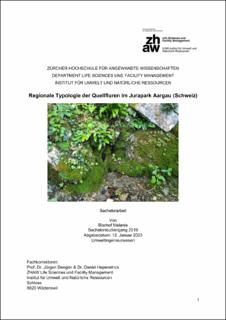Please use this identifier to cite or link to this item:
https://doi.org/10.21256/zhaw-27901| Publication type: | Bachelor thesis |
| Title: | Regionale Typologie der Quellfluren im Jurapark Aargau (Schweiz) |
| Authors: | Bischof, Melanie |
| Advisors / Reviewers: | Dengler, Jürgen Hepenstrick, Daniel |
| DOI: | 10.21256/zhaw-27901 |
| Extent: | 37 |
| Issue Date: | 2023 |
| Publisher / Ed. Institution: | ZHAW Zürcher Hochschule für Angewandte Wissenschaften |
| Publisher / Ed. Institution: | Winterthur |
| Language: | German |
| Subjects: | Aargau; Helokrenen; Kalktuff; Numerische Klassifikation; Pflanzensoziologie; Quellen; Quellflur; Typologie; Schweiz; Vegetation; Calcareous; Helocrene; Numeric classification; Phytosociology; Spring; Switzerland; Tufa; Typology; Vegetation |
| Subject (DDC): | 333.7: Land, natural recreational areas 580: Plants (Botany) |
| Abstract: | Quellen sind nicht nur als Frischwasserspender wichtig, sondern beherbergen auch viele seltene Arten, welche auf ihren einzigartigen Lebensraum angewiesen sind. Regionale Typologien der Quelllebensräume sollen dabei unterstützen, den rechtlich festgeschriebenen Schutz der Quellen auch praktisch umzusetzen. Die Pflanzensoziologie der Quellfluren ist momentan noch kontrovers. Die Arbeit soll dazu beitragen, die Quellen regional im Jurapark Aargau zu klassifizieren, um den Quellschutz zu stärken. Der Jurapark Aargau ist ein regionaler Naturpark der Schweiz, welcher sich in den Ausläufern der Jurakette befindet. Es wurden 20 Quellen untersucht und in jeweils drei Aufnahmen à 1 m2 die gesamte Vegetation (Gefässpflanzen & Moose) kartiert, sowie strukturelle, physikalische und chemische Parameter erfasst. Die Vegetationsdaten wurden mittels einer modifizierten TWINSPAN-Analyse klassifiziert, woraus dann Vegetationseinheiten abgeleitet und mit der Literatur verglichen wurden. Insgesamt wurden 131 Gefässpflanzen- und 36 Moosarten gefunden mit einer durchschnittlichen Artenzahl von 13.3 Arten pro Aufnahme. In der Klassifikation wurden sechs Einheiten definiert. Jeweils eine für Quellen im Offenland (Carex-flaccae-Gesellschaft), eine für schwach sickernde, lichte Waldquellen im Caricion remotae Kästner 1941 (Caricetum remotae Kästner 1941) und drei Einheiten im kalkreichen Cratoneurion commutati Koch 1928 (Cratoneuretum filicino-commutati [Kuhn 1937] Oberdorfer 1977, Eucladietum verticillati Allorge 1922, Brachythecio rivularis-Cratoneuretum Dierßen 1973). Die Offenlandquellen, obwohl im gesamten Gebiet nur zwei Quellen mit genügend grosser Quellflur gefunden wurden, sind klar von den Wald- und Tuffquellen zu unterscheiden. Im Gebiet wurden besonders schöne Tuffquellen gefunden, welche vor touristischem Einfluss zu schützen sind. Weiter sind alle Quellen vor Eutrophierungen und Trittschäden durch die Landwirtschaft sowie Schäden durch den Forst und Strassenbau zu schützen. Da Quellen für die Flora spannende Lebensräume sind, die starkem Nutzungsdruck unterliegen, ist es dringend notwendig den Schutz zu verstärken und die geltenden Gesetze in der Praxis durchzusetzen. Freshwater springs are not only important as drinking water sources, but also host many rare species that depend on this unique habitat. Regional typologies of spring habitats support the practical implementation of the existing laws for the protection of springs. The phytosociology of spring habitats is currently still controversial. This work shall contribute to a regional classification of the spring vegetation in the Jurapark Aargau in order to strengthen the protection of springs. The Jurapark Aargau is a regional nature conservation park of Switzerland, which is located in the foothills of the Jurassic mountains. 20 springs were investigated and in each three plots of 1 m2 were investigated for the entire vegetation (vascular plants & bryophytes), as well as structural, physical and chemical parameters. The vegetation data were classified using modified TWINSPAN analysis, from which vegetation units were then derived and compared to the literature. A total of 131 vascular plants and 36 bryophyte species were found with an average species number of 13.3 species per plot. The classification defined six units. One for springs on grassland (Carex-flaccae society), one for weakly seeping, light forest springs in the Caricion remotae Kästner 1941 (Caricetum remotae Kästner 1941) and three units in the calcareous Cratoneurion commutati Koch 1928 (Cratoneuretum filicino-commutati [Kuhn 1937] Oberdorfer 1977, Eucladietum verticillati Allorge 1922 and Brachythecio rivularis-Cratoneuretum Dierßen 1973). Although only two springs with sufficiently large spring vegetation were found on grassland, this unit is clearly distinguishable from the forest and tufa springs. In the park were found particularly beautiful tufa springs, which should be protected from tourist influence. Furthermore, all springs are to be protected from eutrophication and trampling damage caused by agriculture as well as damage caused by forestry and road construction. Springs are interesting habitats for the flora, but are also subject to strong pressure of exploitation. There is an urgent need to strengthen protection and enforce current laws in practice. |
| URI: | https://digitalcollection.zhaw.ch/handle/11475/27901 |
| License (according to publishing contract): | CC BY 4.0: Attribution 4.0 International |
| Departement: | Life Sciences and Facility Management |
| Appears in collections: | Bachelorarbeiten Umweltingenieurwesen |
Files in This Item:
| File | Description | Size | Format | |
|---|---|---|---|---|
| 2023_Bischof_Melanie_BA_UI19.pdf | 2.41 MB | Adobe PDF |  View/Open |
Show full item record
Bischof, M. (2023). Regionale Typologie der Quellfluren im Jurapark Aargau (Schweiz) [Bachelor’s thesis, ZHAW Zürcher Hochschule für Angewandte Wissenschaften]. https://doi.org/10.21256/zhaw-27901
Bischof, M. (2023) Regionale Typologie der Quellfluren im Jurapark Aargau (Schweiz). Bachelor’s thesis. ZHAW Zürcher Hochschule für Angewandte Wissenschaften. Available at: https://doi.org/10.21256/zhaw-27901.
M. Bischof, “Regionale Typologie der Quellfluren im Jurapark Aargau (Schweiz),” Bachelor’s thesis, ZHAW Zürcher Hochschule für Angewandte Wissenschaften, Winterthur, 2023. doi: 10.21256/zhaw-27901.
BISCHOF, Melanie, 2023. Regionale Typologie der Quellfluren im Jurapark Aargau (Schweiz). Bachelor’s thesis. Winterthur: ZHAW Zürcher Hochschule für Angewandte Wissenschaften
Bischof, Melanie. 2023. “Regionale Typologie der Quellfluren im Jurapark Aargau (Schweiz).” Bachelor’s thesis, Winterthur: ZHAW Zürcher Hochschule für Angewandte Wissenschaften. https://doi.org/10.21256/zhaw-27901.
Bischof, Melanie. Regionale Typologie der Quellfluren im Jurapark Aargau (Schweiz). ZHAW Zürcher Hochschule für Angewandte Wissenschaften, 2023, https://doi.org/10.21256/zhaw-27901.
Items in DSpace are protected by copyright, with all rights reserved, unless otherwise indicated.